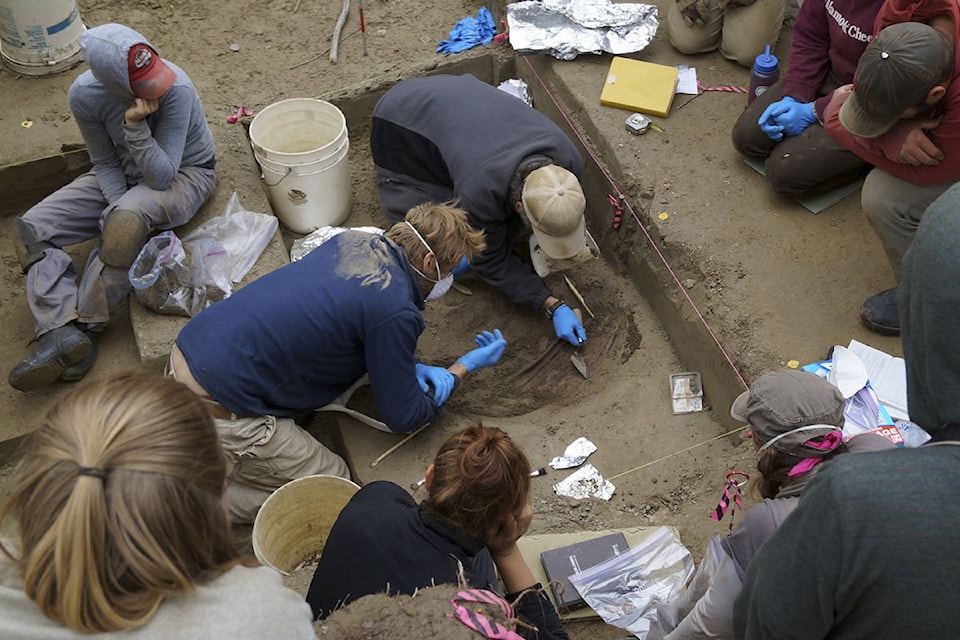The DNA of an ancient child buried 11,500 years ago in interior Alaska is providing new clues about the history and ancestry of the Indigenous people who first inhabited the Americas.
The six-week-old child, named Xach’itee’aanenh T’eede Gaay (sunrise girl-child) by the local Tanana community, was uncovered in 2013 at the Upward Sun archaeological site in the Tanana River Valley, Alaska.
She is part of a previously unknown population of ancient people in North America that is believed to have existed since about 20,000 years ago.
Her DNA is the first ancient DNA sequence from a burial that comes from anywhere in eastern Beringia, Yukon or Alaska.
Dubbed the ancient Beringians by the scientists who found her, Xach’itee’aanenh T’eede Gaay’s community is genetically distinct from two other ancient populations that scientists have identified as having lived in the Americas during the late glacial period.
The results of the genetic study were published in the journal Nature this week.
Indigenous people in North and South America, with the exception of Inuit, are believed to be descendants of the same original population who started to split from East Asians about 36,000 years ago.
Thanks to this latest find it’s now believed that about 20,000 years ago the ancient Beringians and the descendents of all other Indigenous people split into two distinct cultural groups.
By 15,000 years ago, the second group split again into what would be considered northern and southern groups. Yukon First Nations are descendants of the “north” branch. ”
This means that by 15,000 years ago three distinct cultures were present in the Americas, instead of the two scientists knew about before finding Xach’itee’aanenh T’eede Gaay.
“Instead of it just being one group of people entering the Americas, now they’ve got at least two,” said Christian Thomas, senior projects archaeologist with the Yukon’s Department of Tourism and Culture. “They believe that 20,000 years ago two groups of people walked through Beringia into the Americas.
“One of them is the relatives … (of) what they call ancient Beringians and the other is the ancestors of northern North Americans and southern North Americans.
From a genetic perspective, finding ancient human remains from Beringia was “at the top of our wish list,” said Victor Moreno-Mayar, who worked on the genetics at the University of Copenhagen’s Natural History Museum of Denmark, at a press conference announcing the results.
But the discovery means there are more questions to answer.
There are questions about how the newly-discovered ancient Berigians lived.
“Now we know that these people were here, they established themselves over many thousands of years, they were a very successful population in the Far North,” said Ben Potter, one of the lead authors of the study and a professor of anthropology at the University of Alaska Fairbanks.
“That raises again new questions for adaptation, new questions for how they dealt with climate change in this region.… This was the last major period of profound and significant climate shifts and extinctions that we haven’t seen until the present day.”
Thomas said the DNA has started to become part of anthropology and is based on only a few samples.
There is the child burial found in Siberia from about 24,000 years ago, a second burial from about 12,500 years ago found in the Rocky Mountains and the famous Kennewick Man found in Washington who is believed to be about 9,000 years old. All of those would qualify as “southern” Indigenous DNA, not the northern branch which Yukon First Nations belong to, he said.
So far there have been no genomes found belonging to the ancient ancestors of First Nations people in the Yukon.
“The northern North American branch of the tree is entirely recreated using modern DNA from a limited sample of people from the southern rocky mountains,” he said.
As for what happened to the ancient Berigians, Potter said there aren’t enough other genetic samples from northern populations to be sure.
He suggests that they may have been absorbed into the Dene population.
Finding a new culture that lived in Alaska has provided more evidence of just how long Indigenous people have been living in the North, Thomas said.
“We would have thought 20 years ago that First Nations people kind of found the North and the Americas maybe 12,000 years ago, maybe 13,000 years ago,” he said.
“That genetic ancestry that we’re seeing in these genomes is showing that these people were living in the North for extremely long periods of time.”
Contact Ashley Joannou at ashleyj@yukon-news.com
